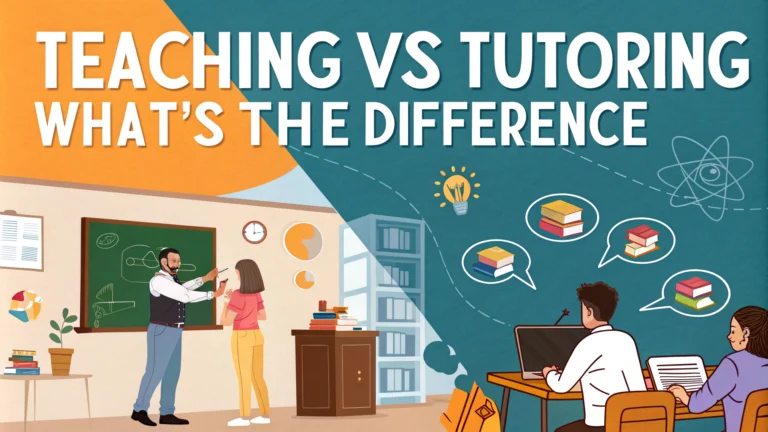Many educators and students often wonder about the distinct roles of teachers and tutors in education. While both professions focus on student learning, they serve different yet complementary purposes in the educational journey.
Understanding these differences helps students, parents, and educators make informed decisions about which approach best suits specific learning needs. The right choice between teaching and tutoring can significantly impact academic success.
Core Characteristics and Working Environment
Teachers work with larger groups in structured classroom settings, following standardized curricula and assessment methods. Tutors provide personalized, one-on-one or small group instruction, tailoring their approach to individual student needs.
- Teachers manage 20-30 students on average
- Tutors typically work with 1-3 students at a time
- Teachers follow strict schedules and curricula
- Tutors offer flexible timing and customized learning plans
Goals and Objectives
The primary focus differs between these roles. Teaching aims to deliver comprehensive subject knowledge to an entire class, while tutoring targets specific areas where students need additional support.
| Teaching Goals | Tutoring Goals |
|---|---|
| Cover full curriculum | Address specific challenges |
| Meet standardized benchmarks | Improve individual performance |
Learning Approach and Methodology
Teaching methodologies often follow structured lesson plans and standardized assessment tools. Tutoring approaches adapt to individual learning styles and pace.
“Teaching is about managing group dynamics, while tutoring focuses on individual achievement and overcoming specific obstacles.”
Assessment Methods and Progress Monitoring
Teachers rely on standardized tests, quizzes, and assignments to evaluate large groups. Tutors use ongoing feedback and customized assessments to track individual progress.
| Teacher Assessment | Tutor Assessment |
|---|---|
| Formal exams and tests | Real-time feedback |
| Grade-based evaluation | Progress-based evaluation |
| Group performance metrics | Individual improvement tracking |
Time Structure and Scheduling
School-based teaching follows fixed schedules with predetermined class periods. Tutoring sessions offer flexibility in timing and duration based on student availability and needs.
- Teaching hours: Fixed school day schedule
- Tutoring hours: Flexible, including evenings and weekends
- Class duration: Standard 45-60 minutes
- Tutoring sessions: Adjustable 30-120 minutes
Professional Requirements and Expertise
Both roles demand different qualifications and skill sets to effectively support student learning.
| Teacher Requirements | Tutor Requirements |
|---|---|
| Teaching license/certification | Subject matter expertise |
| Education degree | Teaching experience (varies) |
| Classroom management skills | Individual instruction skills |
“The best educational outcomes often come from combining classroom teaching with targeted tutoring support.”
Choosing Between Teaching and Tutoring Support
Select the right educational support based on specific learning goals and circumstances.
Consider These Factors:
- Learning style preferences
- Academic performance level
- Schedule flexibility needs
- Budget constraints
- Subject complexity
Regular classroom teaching provides essential foundational knowledge, while tutoring offers targeted support for specific challenges or advanced learning goals.
Teaching vs Tutoring FAQs
General FAQs
Q: What is the main difference between teaching and tutoring?
A: Teaching involves instructing larger groups in a structured classroom setting, while tutoring provides personalized, one-on-one or small group instruction tailored to specific student needs.
Q: Which pays more – teaching or tutoring?
A: Full-time teachers typically earn a steady salary with benefits, while tutors often charge hourly rates ranging from $25-$100+. Experienced private tutors can potentially earn more per hour than teachers.
Q: Do tutors need teaching certifications?
A: Most private tutors don’t require formal teaching certifications, though credentials and subject expertise are valuable. Teachers in public schools must have state-specific teaching licenses.
Long-tail Keyword FAQs
Q: Can I be both a teacher and private tutor at the same time?
A: Yes, many teachers supplement their income through private tutoring outside school hours, as long as it doesn’t conflict with their teaching contract.
Q: What qualities make someone better suited for tutoring vs classroom teaching?
A:
- Tutoring suits those who excel at:
- Individual attention
- Flexible teaching approaches
- Custom-paced instruction
- Classroom teaching suits those who excel at:
- Group management
- Structured curriculum delivery
- Multi-tasking
Q: How do teaching methods differ between tutoring and classroom instruction?
A: Classroom teaching follows structured curricula with standardized assessments, while tutoring allows for adaptive methods based on individual learning styles and immediate feedback.
Q: What’s the difference between online tutoring and virtual classroom teaching?
A: Online tutoring offers flexible scheduling and one-on-one attention through video platforms, while virtual classroom teaching maintains traditional class schedules and group instruction through learning management systems.
Q: How much experience do you need to become a private tutor?
A: Entry-level tutors typically need strong subject knowledge and basic teaching skills. Most tutoring platforms require a bachelor’s degree and/or proof of subject expertise.
Q: What’s better for test prep – private tutoring or classroom instruction?
A: Private tutoring is generally more effective for test prep as it targets individual weaknesses, provides focused practice, and adapts to specific testing goals.
Q: How do student outcomes compare between tutoring and classroom teaching?
A: Research shows that one-on-one tutoring can lead to significant improvements in academic performance, while classroom teaching provides broader educational development and social learning opportunities.
| Aspect | Teaching | Tutoring |
|---|---|---|
| Group Size | 15-30+ students | 1-3 students |
| Schedule | Fixed | Flexible |
| Curriculum | Standardized | Customized |



















